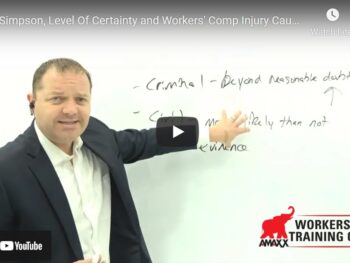Five weeks ago, a decision was published dealing with a worker who had a severe hand injury (Barclay v. Techno Design, Inc.) The decision hinged on whether the injury met the statutory requirements for a “serious” injury, which required the loss of fingers (the worker had loss the use of the fingers). The court held it was not a serious injury, according to the statutory definition.
Contradiction of High Court Decision
What is interesting about this decision is that the very same issue was the subject of the very first NY work comp decision to be issued by NY’s highest court (the Court of Appeals) in 1915!! The decision, “Matter of Petrie”, said that loss of USE of a finger is the same as actual loss of the finger –directly contradicting this latest decision a century later. The new decision made no mention of “Matter of Petrie”.
Your correspondent was planning on writing a piece about that first decision, to honor its centennial, but this newest decision now compels it. “Matter of Petrie” is the most cited case in NY comp and created the principle of liberal interpretation of the statute. Yet, somehow, in recent years the source of that principle has been forgotten.
Basic Principles Should Not Be Taken For Granted
The point of this piece is to emphasize that basic principles should not be taken for granted. The most important ones will fall into a black hole unless we understand where and how the basics arose. The present story is not finished. The recent decision was issued by the Appellate Division, which is one level below the Court of Appeals, so the result may well change in the near future.
1930 Amendment to Permit Employer to Change Treating Doctor
What other principles have been forgotten which might be of use to employers? Well, in 1930 the statute was amended to permit the employer to change the treating doctor if it was in the best interest of the worker (WCL Sect 13-a(3)). This was changed to prevent workers from being swept up by dubious medical practices. This is still the law, although few today believe it – it too has been forgotten. But every employer should write, preserve and remember that section. It needs to be judiciously used.
Long Term Disability Liens
In 1986, long term disability plans tried to assert a lien on NY comp awards – but were rebuffed with the statement that no such lien existed. However, a search of the law and Board forms showed that such a lien was established in 1947 (Sect 25(4)(c)) and the Board had created forms (still in force in 1986) for long term disability carriers to use. (The forms were found in a manila folder which had not been opened since 1952.)
Location of Board Headquarters
The NY comp law also required that the Board headquarters be in Albany and be open six days a week. For almost 70 years the Board headquarters was in lower Manhattan and was NEVER open six days a week. (That has since been corrected.)
Remember These Sections Exist
Employers cannot be expected to be work comp historians. But they can make the effort to find out what details of the law benefit them and, gently, remind others that those sections still exist.
Author: Attorney Theodore Ronca is a practicing lawyer from Aquebogue, NY. He is a frequent writer and speaker, and has represented employers in the areas of workers’ compensation, Social Security disability, employee disability plans and subrogation for over 30 years. Attorney Ronca can be reached at 631-722-2100. medsearch7@optonline.net
©2015 Amaxx Risk Solutions, Inc. All rights reserved under International Copyright Law.
SALES TO PAY FOR ACCIDENTS CALCULATOR: http://reduceyourworkerscomp.com/sales-to-pay-for-accidents-calculator/
MODIFIED DUTY CALCULATOR: http://reduceyourworkerscomp.com/transitional-duty-cost-calculators/
WC GROUP: http://www.linkedin.com/groups?homeNewMember=&gid=1922050/
SUBSCRIBE: Workers Comp Resource Center Newsletter
Do not use this information without independent verification. All state laws vary. You should consult with your insurance broker, attorney, or qualified professional.










